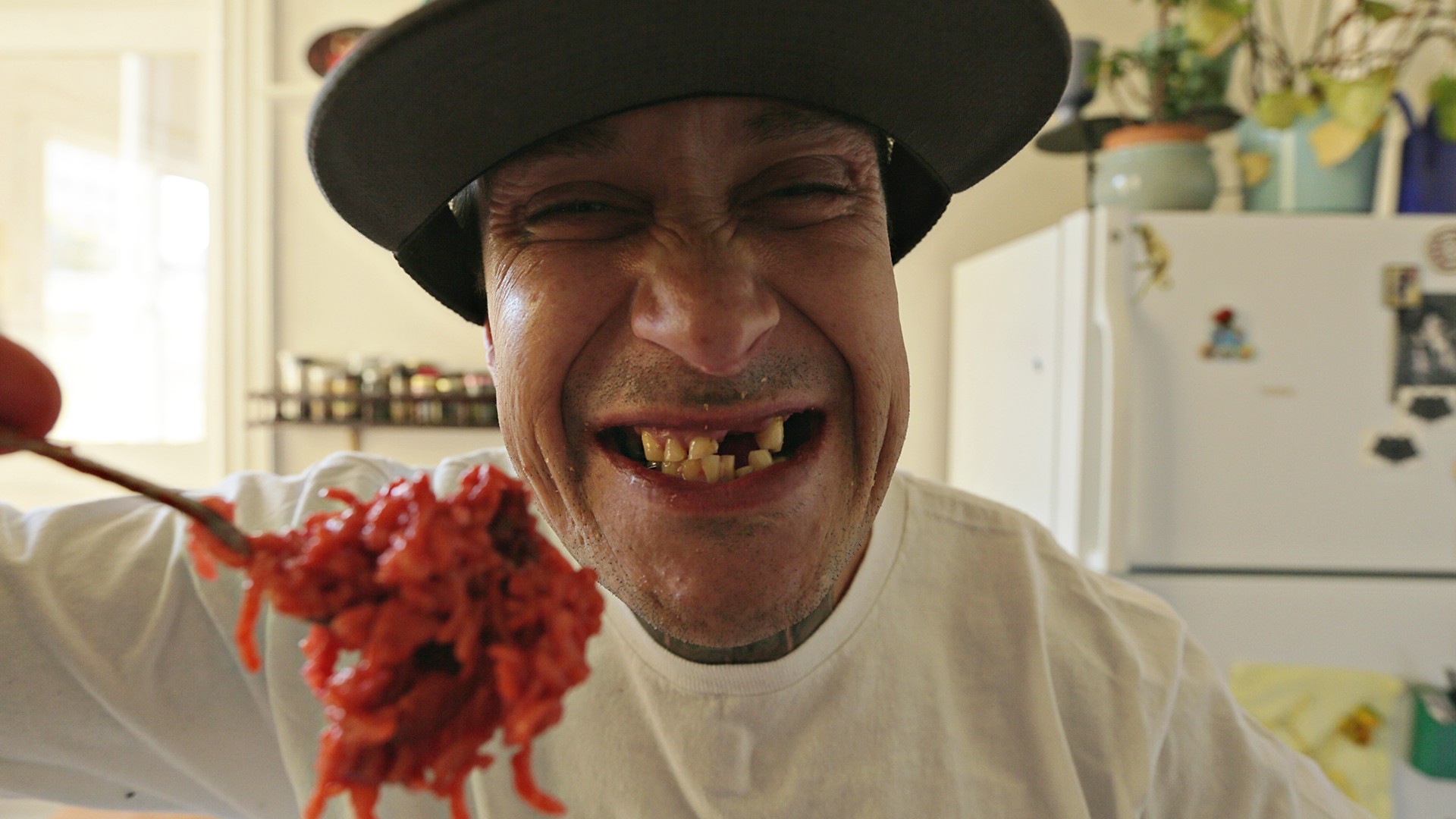This article originally appeared on MUNCHIES Denmark in 2016.“God, what a weird day. I really hope they let him out. I can’t wait to see him again.”The young girl’s remarks ring out unanswered in the clinical, compact waiting room of the visitation facilities at Vestre Prison. She’s sitting on a bench, huddled closely to an older woman, perhaps her mother. They look nervous. There’s not much encouragement to be found in the yellow wall tiles and gray linoleum floor that make up the small room’s drab institutional decor.
Advertisement
It's the day after Donald Trump’s electoral victory, and the whole world has woken up with something that feels like a gigantic collective hangover. But it’s still nothing compared to being deprived of one’s freedom and daily contact with friends and family.And that’s precisely the prisoners’ plight while they’re serving or awaiting sentencing at Vestre Prison in Copenhagen. But whatever the nature or magnitude of the crime, an inmate still needs a meal three times a day.Here’s where chef Kim Wichmann comes into the picture. After undergoing a thorough security check and surrendering our cell phones, we’re led through the prison yard to Vestre Prison’s kitchen. For the past year and a half, this is where Wichmann has occupied one of Denmark’s more unique culinary positions.In the prison’s main kitchen, Wichmann and 11 other full-time employees work side by side with about 20 inmates. They make 700 packages of food for Vestre Prison’s approximately 500 "residents," for the employee cafeteria, as well as for Blegdammen and the Police Headquarters’ prison, which are Copenhagen’s other two municipal prisons.Sharp kitchen knives, boiling water, and convicts may not sound like the smartest combination in the world, but the reality in this prison’s kitchen is far from being as dramatic as one might think, Wichmann tells us.“The inmates we have here are pretty level-headed. I’ve been here for a year and a half now, and there’s never been any serious trouble. The work here isn’t actually much different than at other large-scale kitchens that put together a lot of meals. But of course our larger knives are secured to the wall with steel cables, and we keep close tabs on how many paring knives are supposed to be in the drawers.”
Advertisement
As an inmate, you must obtain security clearance to get permission to work in the kitchen. For obvious reasons, it wouldn’t be good fit to have people who are unstable or mentally ill in an industrial kitchen. Inmates also have to get medical approval; anyone actively battling addiction is banned from kitchen work due to the potential contamination risk from open wounds.Vestre Prison serves primarily as a holding facility where people are kept in custody while awaiting sentencing. Here, inmates spend many hours of the day alone. The kitchen work is fully voluntary, and for the inmates, the kitchen is almost a refuge where they can get a bit of human contact independent of their legal case. If they enjoy the work, they can undergo vocational training as bakers or cooks.“We operate under a concept we call dynamic security. What that means is that soon as you establish even a little bit of rapport with another person, then you’ve already created the first barrier against violence,” Wichmann explains. “When you work closely with people in a kitchen, you can’t help but bond with them in one form or another.”“We cook together and eat lunch together on the weekends, which strengthens our relationship. I think most of them enjoy working here. We laugh a lot while we’re working, in any case. I hadn’t quite expected that when I was just starting here,” says Wichmann.In the kitchen we walk past two inmates, laughing as they struggle to mix a massive amount of potato salad with creme fraiche and chives in one of the two enormous pots in the middle of the room. The only difference between them and Kim is that they’re wearing red work pants, while Wichmann’s are black.
Advertisement
“The simple fact that we don’t wear uniforms in the kitchen contributes to the special relationship we have to our inmates. That’s where we have a big advantage over the uniformed staff. The funny thing is that as soon as they take their uniforms off and don shorts and t-shirts to play soccer with the inmates, then they get treated differently as well.”Dreams of working at a prison cafeteria were not what fed Wichmann’s culinary ambitions when he started his training. Rather, the dream of Michelin stars drew him to London and the French restaurant Roussillon, which had a star in the Michelin Guide and the Alain Ducasse-inspired Frenchman Alexis Gauthier as its head chef.Wichmann had come directly to London from Damhuskroen, a nightclub and event venue in Rødovre, a city on the island of Zealand in eastern Denmark. The transition to a hectic British restaurant environment was like being thrown into another world. After three years sweating over the stoves in London, he was worn out.He went back to Copenhagen to hunt for a job where he might spend fewer hours in a chef’s coat. When a friend recommended he apply for a vacant position as a prison chef, his curiosity won out.“It’s exciting, because I work as a chef here, but in reality I’m also a sort of gastronomic social worker. I never ask how people ended up in prison. But a lot of them want to talk about it. So we have to be what they call ‘good role models’. We should never treat people differently or judge them. That’s someone else’s job.”
Advertisement
The contrast to a French Michelin-starred kitchen in London could hardly be greater, but that’s not something that bothers Wichmann—to the contrary.In Vestre Prison’s kitchen, he works with a food budget of about 45 crowns (about $7.50 USD) per inmate for three daily meals. That doesn’t leave much room for lobster or caviar. Behind these bars, it’s rustic Danish farm cooking that sets the agenda.Meatballs with stewed cabbage and potatoes, pork tenderloin with caramelized onions and gravy, and baked pork chops—even behind bars, pork is king. These traditional Danish dishes are served alongside a number of classics from world gastronomy like pulled pork sliders, pasta bolognese and chicken in red curry.“It’s not rocket science,” Wichmann says. “But it’s very important to me that it’s done right. It makes little difference to me that I rarely meet the people we cook for. We didn’t get to in London, either. That was before it became fashionable for cooks to go out on the floor to present the food. As long as I know the food is good, that’s all that matters.”You might not believe it, but a large proportion of the food in Danish prisons is organic. Vestre Prison is just shy of attaining bronze certification in Denmark’s organic food label system, but the goal is silver, which is awarded for using organic ingredients in the 60-90 percent range. The shift to organic is a core cause for the Danish prison system. They have managers and employees attend courses and learn to create menu plans based on seasonal produce. Some of the organic ingredients even come from the prison system’s own farms, which made the transition to organic back in 2000.
Advertisement

Inmates without food restrictions get the ‘complete’ menu plan, free from dietary or religious considerations. Vegetarians, those with gluten allergies, and religious inmates have their own menu options: meat-free, no pork, and so on. Vestre Prison even has its own infirmary meal program, which provides special diets to patients with cancer and other maladies.Dinner is always made a day ahead of time, so the workday wraps up every day at 2:30 PM. When the food is ready, it’s divided up into servings, cooled down and placed onto speed racks—those towering racks on wheels which hold lots of sheet pans. As dinner approaches the next day, the racks are rolled out to each wing, where an inmate volunteer warms up the food. Then the prison guards take over, transporting the food to each individual cell.Before we slink away to freedom again, we just have to try one of the prison baker’s creations: a sublime frangipane cake with a chocolate mousse filling and coated with dark chocolate.When people hear that Wichmann works as a chef, they often ask if they’ve tasted his food anywhere.“That’s not something I would hope for you,” is his usual playful reply.If the food is worth going to prison for, well, that’s up for discussion. But at the very least, the food at Vestre Prison doesn’t feel like a punishment.
